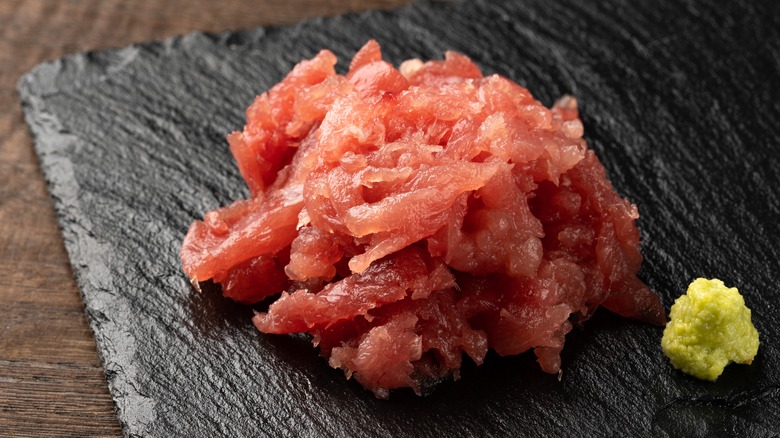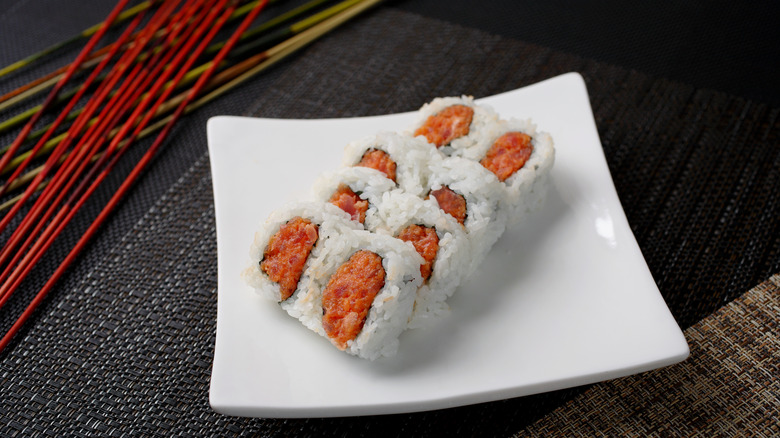What Is Tuna Scrape And Why Is It In Your Sushi?
There's a special delight to sushi night — fresh ingredients, vivid colors, and an enticing range of flavors. Order classics like nigiri, a plate of sashimi, or a delicious roll, and you won't be disappointed. Plus, if you remember to always follow tips on eating sushi, it can ensure a delightful experience.
Truthfully, there's not much of a secret: The magic's all in the fish. The variety, where it's caught, and how it's processed are some of the factors that contribute to the final experience. As a result, there's substantial effort that goes into sourcing quality seafood, and such details distinguish what's good from the very best. Take that chopped, slightly mushy mixture that comprises a spicy tuna roll, for example. With a name like tuna scrape, it won't win over many diners. But when well-sourced, it's a tasty sushi option.
There's absolutely nothing wrong with the foodstuff — it's simply the meat scraped off of the fish bones. Since whole fish packs in more flavor and juiciness, such a quality extends to raw fish, too. Tuna scrape is high in fat, lending it a delectable taste and melt-in-your-mouth consistency. With such a rich flavor, tuna scrape even draws comparisons to toro, the prized tuna belly cut. Plus, there are benefits to its sustainable nature, with its consumption helping minimize food waste. So, don't overlook tuna scrape sushi; it's a delectable raw fish which certainly deserves a place in your sushi.
Tuna scrape is comprised of small meaty bits adhered to the bones
In Japan, tuna scrape is known as negitoro, and its applications are varied. As a delicious and more affordable fish cut, it's a frequent topping for donburi — casual rice bowls — as well as in gunkanmaki, an open-faced sushi type. Tuna scrape is also enjoyed as a tartare-like dish on its own, perhaps seasoned with soy sauce. Starting in the 20th century, Japanese chefs also started integrating chopped green onion, an addition which deftly softens the delectable tuna cut. And with Tokyo's status as the most affordable city for Michelin dining, you're bound to find even more creative renditions with the product.
In the U.S., tuna scrape is strongly intertwined with the spicy tuna roll. Although this sushi type isn't always made with the cut, it's a frequent filler in commercially-produced sushi at restaurants and grocery stores. Typically, it's combined with a hot sauce like sriracha, some sesame oil, and green onions — the same tenderizing addition as in Japan. The mixture is rolled and cut like other sushi, making it one of many tantalizing roll options.
As with other raw fish, tuna scrape presents health risks
Unfortunately, tuna scrape often receives negative press due to health risks. As reported on PBS News, large salmonella outbreaks — such as one involving 425 people in 2012 — are occasionally associated with the foodstuff. Since the meat bits are often processed and packaged in factories abroad, tuna scrape can elude a suspicious character. This has lended it a negative tone akin to pink slime, a name for processed beef trimmings.
Indeed, there is a risk associated with the consumption of raw fish, a danger that applies to any cut. In part, it's due to the confusing sushi grade nomenclature, which ensures that caught fish is deep-frozen, but doesn't offer much additional guidance. Some bacteria can survive such low temperatures, so while there's safety in freezing parasites, it's not a definitive precaution. Some speculate that tuna scrape's more piece-by-piece nature may make it more susceptible, which might be true, but there's not enough statistical backing to this claim. There's a risk to eating any raw fish, making potential infections difficult to eliminate.
So, to be extra cautious, always purchase fish or eat sushi from a trusted source, because it's certainly one of five food items you never should buy at a gas station. Foster relationships with fishmongers and chefs to add both reassurance and insight regarding fish sourcing practices. Plus, when you shop and dine at well-regarded establishments, you won't only ease health concerns, but you'll be rewarded with better flavor, too.


